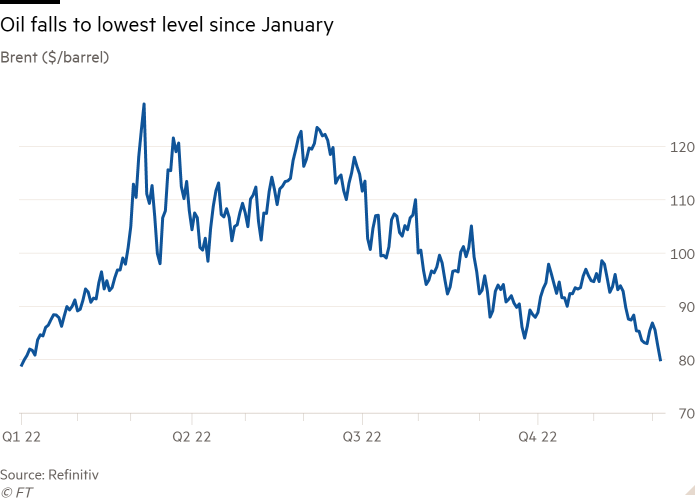US stocks slid and the price of Brent crude touched its lowest level since January after a round of strong economic data revived concerns that the Federal Reserve will rapidly lift borrowing costs to tame inflation.
The benchmark S&P 500 was down 1.2 per cent and the tech-heavy Nasdaq Composite fell 1.5 per cent in morning trade in New York on Tuesday, extending their heavy declines from the previous session.
Brent crude, the international oil benchmark, fell below $80, down 3.6 per cent, as traders took hotter than expected US services data on Monday as a signal the Fed would continue to raise rates to fight inflation.
Investors took fright at a report from the Institute for Supply Management showing that its index, which tracks economic activity in the US services sector, expanded for the 30th month in a row in November. The Fed has raised its main rate to target range of 3.75 per cent to 4 per cent from zero at the start of the year.

“A stickier inflation outlook increases the prospect of a weaker economy heading into 2023,” said Michael Hewson, chief market analyst at CMC Markets in the UK.
Fresh data on Tuesday suggested American oil demand this year would be slightly less than previously expected — up 470,000 barrels a day rather than 490,000 barrels a day as previously suggested.
Paul Horsnell, head of commodities research at Standard Chartered said oil was responding negatively to both good and bad economic data. “Oil has tended to be caught in the backwash from top-down macro trades,” he said.
“A negative US economic data point causes oil to be sold as recessionary fears increase, but a positive data point can also cause oil selling through being good for the US dollar and negative for risk assets,” he added. “There is always interplay between those effects, but in the past three weeks oil has tended to fall after both good and bad economic data.”
The Fed is set to hold its final meeting of the year next week, and the European Central Bank and Bank of England are also set to make policy decisions.
US government bonds gained in price on Tuesday after selling off sharply following the ISM release. The yield on the interest rate-sensitive two-year Treasury fell 0.01 percentage points to 4.38 per cent. The yield on the benchmark 10-year note lost 0.04 percentage points at 3.56 per cent. Yields fall as prices rise.
Short-term debt yielding more than long-term debt tends to indicate an impending recession. Julian Howard, lead investment director at GAM, said the Treasury market was “correctly hinting that the [US] economy is going to get really, really hit”.
Meanwhile, Europe’s Stoxx 600 fell 0.6 per cent, with London’s FTSE 100 off by the same margin. Hong Kong’s Hang Seng index shed 0.4 per cent, while China’s CSI index of Shanghai- and Shenzhen-listed stocks gained 0.5 per cent.
Futures on the European gas benchmark, TTF, rose as much as 4 per cent to €141 a megawatt hour following a spell of cold weather in northern Europe.
